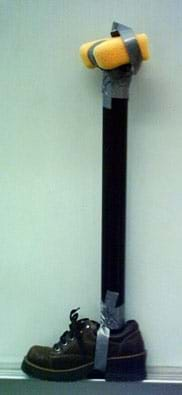Quick Look
Grade Level: Middle school
Time Required: 1 hour
Expendable Cost: US $2.00
Group Size: 3
Subject Areas: Biology, Life Science, Science and Technology
Introduction
Bolded words are vocabulary and concepts to highlight with students during the activity.
For one reason or another, many people require replacement body parts, called prostheses or artificial limbs. Those who need artificial legs must have a structurally stable one in order to replace a critical part of their skeletal system. One aspect of biomedical engineering is designing and researching new and better prostheses for people with this medical need. Biomedical engineers are continually improving the strength, durability, longevity and lifelikeness of prosthetic devices so amputees can lead full lives. 
Supplies
- 1 roll duct tape
- 1 yardstick or tape measure
- 1 large sponge
- scissors
- roll string
- 1 ~2 ft. (60 cm) cardboard tube
- 1 sheet paper
For the class to share:
- miscellaneous cardboard pieces
- small hand saw
Subscribe
Get the inside scoop on all things TeachEngineering such as new site features, curriculum updates, video releases, and more by signing up for our newsletter!Procedure
Procedures Overview
Student groups use simple materials to create prosthetic legs to replace the lower half of a leg. Then they test the legs and make improvements to their initial designs to increase their stability, comfort and aesthetics.
Procedure
- Lead a class discussion, focusing on the following questions:
- What is a prosthesis? (Answer: A prosthesis is an artificial body part to replace a missing one.)
- Why might someone need a prosthesis? (Answer: Because of an accident, war injury, etc.)
- What features would make a useful prosthetic leg? (Answer: Strength, stability, durability, lifelikeness, comfort, etc.)
- Organize students into groups of three.
- Pass out a sheet of blank paper to each group.
- Explain to students that their challenge is to make a prosthetic lower leg that one of them must be able to wear to walk around the room.
- Show students the available materials and have them brainstorm ideas on how to achieve the features discussed in answering the questions in Step 1.
- Remind students of the steps of the engineering design process: identify the problem, research the problem, develop possible solutions, select best solution, build a prototype, test and evaluate, and finally, redesign as necessary.
- Tell student groups that they must draw design sketches, which must be approved by the instructor before they can proceed to fabrication.
- Once sketches are approved, hand out materials and give students time to build their prosthestic prototoypes.
- Advise the teams to cut their tubes to (approximately) match the size of their designated tester's lower leg. (Note: Have students mark a "cut" line on the tube indicating the desired length where they want the instructor to cut the tube using the hand saw.)
- Supervise each group's "test" phase to offer constructive criticism and be on hand in case the support breaks under the student's weight.
- After testing, have groups make at least two improvements to their initial designs.
- Allow time for students to test their prostheses again after making their design changes.
- Provide enough time for student groups to show their designs to the rest of the class and discuss their reasoning for their prosthesis.
Hints
For safety reasons, instruct teams to pick the lightest member of the group to test the prototypes.
Wrap Up - Thought Questions
- What worked well about your design? Why?
- What did not work well? Why not?
- If you had additional materials, what improvements would you make?
More Curriculum Like This

Student teams investigate biomedical engineering and the technology of prosthetics. Students create lower-leg prosthetic prototypes using various ordinary materials.

Students extend their knowledge of the skeletal system to biomedical engineering design, specifically the concept of artificial limbs and joints. Students relate the skeleton as a structural system, focusing on the leg as structural necessity. They learn about the design considerations involved in t...

Students are introduced to prosthetics—history, purpose and benefits, main components, main types, materials, control methods, modern examples—including modern materials used to make replacement body parts and the engineering design considerations to develop prostheses. They learn how engineers and ...
Copyright
© 2008 by Regents of the University of ColoradoLast modified: May 12, 2022







User Comments & Tips